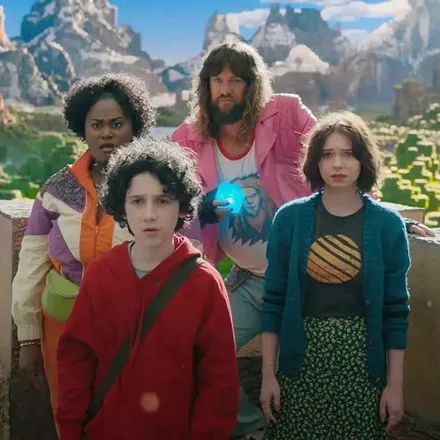Feature movie review: SILENT NIGHT
John Woo has fun with what action cinema can convey without dialogue.
By Scott Renshaw @scottrenshawIt's been 20 years since John Woo directed a feature film set in the U.S., and primarily in English—though Silent Night might earn an asterisk as far as continuing that streak. In the opening sequence, Brian Godlock (Joel Kinnaman) runs down an alley decked out in a gaudy Christmas sweater, a jingle bell bouncing rhythmically on his chest, blood coating his hands; the occupants of two speeding vehicles spray gunfire at one another, and it's not clear whether Brian is running from them or trying to catch them. When one of the cars eventually catches up with him, the driver—a heavily-tattooed gang member—shoots Brian in the throat, leaving him for dead. And though Brian ultimately survives, he's left without the ability to speak—which emphasizes that the film's title is double-entendre both referring to its holiday-time setting, and the fact the story, aside from a few snippets heard over radios, isn't going to be told through words.
Woo made his name in Hong Kong cinema with a uniquely stylized kind of action filmmaking, before he jumped to Hollywood in the '90s with hits like Broken Arrow and Face/Off. It's easy to understand what might appeal to him about a movie that would require him to rely entirely on visual storytelling, and he succeeds at incorporating at all the things his movies have always been best at: exaggerated violence, a dose of melodrama and a willingness to walk the tightrope between absurdity and awesomeness.
Nearly 15 minutes pass in Silent Night before Woo and screenwriter Robert Archer Lynn circle back to clarify what set Brian on his Christmas Eve run. A stray bullet from one of those speeding, gang-warring vehicles killed Brian's 7-year-old son, leaving Brian and his wife Saya (Catalina Sandino Moreno) bereft. Brian spends months in the wake of this event sinking into grief and depression, before he hits on a notion that might give his life purpose: He's going to enact some vigilante justice on the gangs who robbed him of his son, targeting the Christmas Eve one-year anniversary of his son's death for his reign of terror, and spending nine months building up his body, his facility with a gun and his skills behind the wheel.
A whole lot of Silent Night is dedicated to Brian's regimen of watching YouTube self-defense videos, practicing precision turns in his souped-up, armor-plated Mustang and doing weight training while trying to avoid showing us that Kinnaman's torso is already ripped to shreds. These bits start to get a little repetitive after a while, but Woo mixes in scenes showing the disintegration of Brian and Saya's marriage as Silent Night tries to maintain the emotional stakes for Brian's planned vengeful killing spree. Woo isn't shy about amping up the operatic quality as he conveys grief and heartbreak, yet he's also savvy enough to add his own distinctive touch to such moments, as when a single tear falling from Saya's eye hits the ground as a shell casing from Brian's target practice.
The entire dialogue-free hook of Silent Night benefits from the fact that Kinnaman has always been most effective as a physical presence, but the script also takes a surprisingly realistic approach to the idea of an ordinary guy trying to turn himself into a homicidal badass in less than a calendar year. Those extended training montages notably don't involve Brian practicing with another live human, so it's not shocking that Brian's first effort at putting his plan into effect goes south fairly quickly. Silent Night kind of depends on maintaining Brian's humanity amidst all the carnage, so it's an effective touch that the first time he actually kills someone, he responds not with a sense of triumph, but by throwing up.
Ultimately, Brian does get to that date circled on the calendar, assisted by a local cop (Kid Cudi), and the ensuing carnival of shootings, stabbings and punchings might have come off cooler if the John Wick series hadn't spoiled us on how amazing they can be. Still, it's great to see Woo doing his thing again, and being playful enough to set the movie in a town called Las Palomas—"the doves," nodding to one of the director's visual trademarks. American audiences have missed having this guy around, reminding us that there's no particular language you need to understand when you can let your action do the talking.
More by Scott Renshaw
-
Comedian Steve Hofstetter interview
Veteran standup talks about getting started, dealing with hecklers, and learning a valuable lesson in SLC
- Apr 11, 2025
-
Film Reviews: New Releases for April 11
The Amateur, Drop, The Ballad of Wallis Island, Warfare, King of Kings, Sacramento
- Apr 10, 2025
-
Movie reviews: THE BALLAD OF WALLIS ISLAND, WARFARE, THE KING OF KINGS
Wars of words, weapons and ideas drive three new theatrical releases
- Apr 9, 2025
- More »
Latest in Film Reviews
Readers also liked…
-
Sundance 2025 wrap-up plus February special screenings
Uncertainty about the future location shifts focus away from the movies
- Feb 5, 2025









